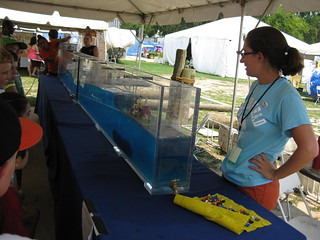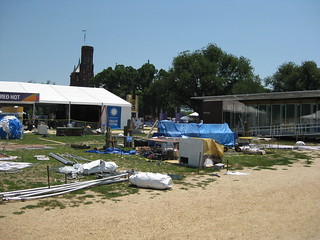WASHINGTON, D.C. Day three of the ten-day Smithsonian Folklife Festival on the National Mall was cancelled after OSU’s tent and at least nine others were damaged by a massive thunderstorm that swept across the capital on Friday night.
On Saturday morning the 16-foot long plexiglass wave tank, borrowed by OSU from Howard University to demonstrate tsunamis, stood on two tables peeking out from under a frayed blue tarp amid a field of debris. Around it laid bent pieces of metal tent tubing, soggy “Powered by Orange” tee shirts, and muddied posters that describe OSU extension and outreach activities.
“I was shocked when the festival representative called this morning and said, ‘well, the wave tank is fine but you’ll need you to stay away for the day while we find you a new tent’,” said OSU Director of University Events Shelly Signs. Signs heads up the team of paid staff and volunteers that has traveled from Oregon to demonstrate OSU research and extension activities. These include tsunami education activities, Sea Grant-related surimi and fisheries research, and projects by the 4-H Tech Wizards—an OSU Extension program that provides after-school tech-related activities for underrepresented youth.
The annual Smithsonian Folklife Festival was created in 1967 to examine and showcase different aspects of American and global culture. To mark the 150th anniversary of President Lincoln’s signing of the Morrill Bill that called for the creation of land-grant universities, Smithsonian invited land-grant universities from around the country to set up exhibits that showcase activities connected with their mission. The program, called “Campus and Community“, features exhibits and activities from 28 U.S. land-grant institutions.
By Sunday, OSU’s tent had been replaced and Signs and her team were busy making tsunamis, rolling out surimi and firing off air-propelled rockets. At tables in front of the wave tank, children and parents snapped together Legos trying to create structures that could withstand the six-inch wave the machine generates. OSU researcher Jae Park and his wife stood by a glass-topped freezer that displayed numerous brands of surimi and spoke to festival goers about how the product utilizes parts of fish that were once discarded (Park’s research and his Astoria-based Surimi School got early support from Oregon Sea Grant). On nearby tables children used surimi molds and rolling pins to make artificial crab and pressed shrimp shapes out of clay.

Smithsonian volunteer and young festival attendees watch to see which structures will withstand the tsunami.
In Reunion Hall, just across from the OSU tent, 4-H Tech Wizards program manager Octaviano Merecias-Cuevas showed one young festival goer how to connect a motor to a solar cell. Behind him teacher Miguel Angel Cholu Hernandez tested the latest batch of air-propelled rockets that had been made at their table.
Despite losing a day, Signs seems happy with the way things are turning out. “People are learning about how to build structures that are less susceptible to tsunamis, they’re learning sustainable food practices and are seeing the great things that the Tech-Wizards are doing,” she said. “Plus we’ve had an opportunity to build community with all of the other land-grant communities that are also participating. I’d say this is a success.”
To see more photos of the event please visit:
http://www.flickr.com/photos/r_register/sets/72157630388536296/
(Rhett Register is a former Corvallis reporter and freelancer now living and working in Washington, D.C., where he is a researcher for National Geographic Travel magazine.)




